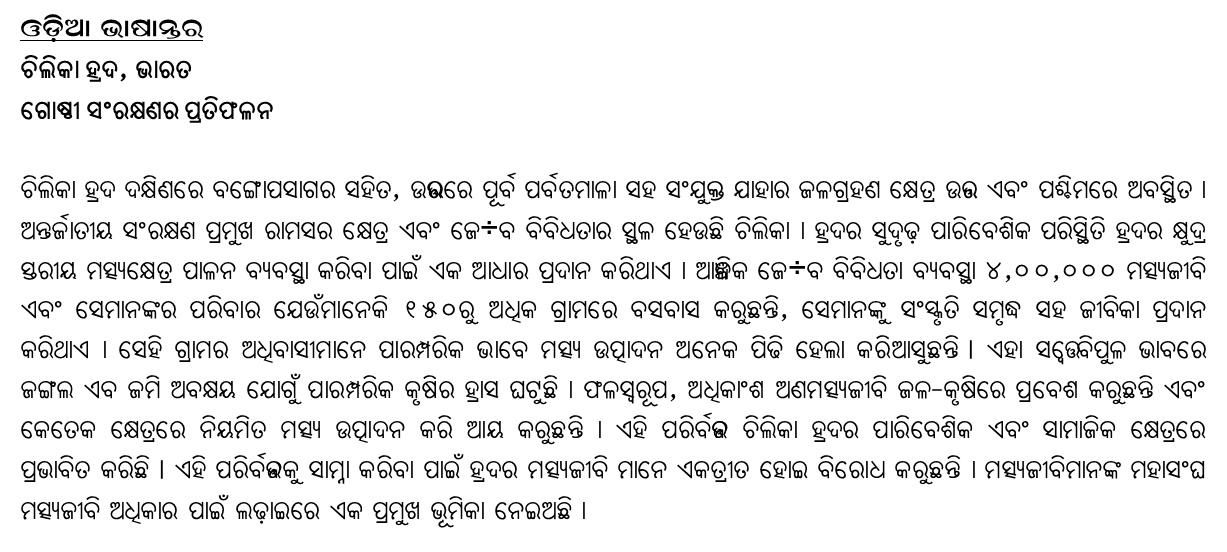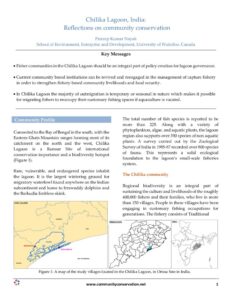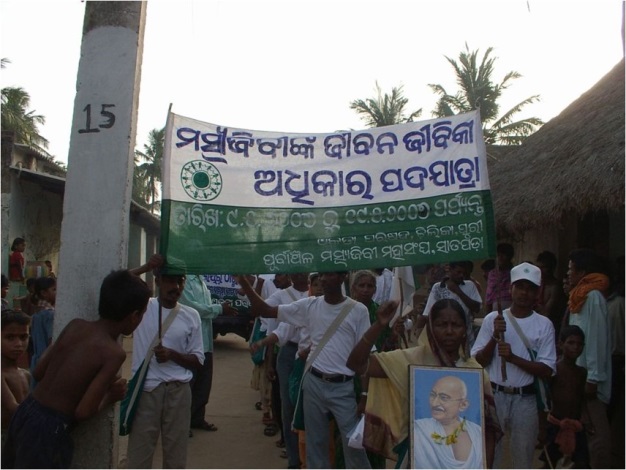
15 Dec Chilika Lagoon, India
Prateep Kumar Nayak
Key Messages
- Fisher communities in the Chilika Lagoon should be an integral part of policy creation for lagoon governance.
- Current community based institutions can be reviewed and re-engaged in the management of capture fishery in order to strengthen fishery-based community livelihoods and food security.
- In Chilika Lagoon, the majority of outmigration is temporary or seasonal in the nature, which makes it possible for migrating fishers to reoccupy their customary fishing spaces if aquaculture is vacated.
Community Profile
Connected to the Bay of Bengal in the south, with the Eastern Ghats Mountain ranges forming most of its catchment on the north and the west, Chilika Lagoon is a Ramsar Site of international conservation importance and a biodiversity hotspot (Figure 1).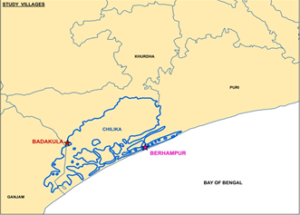
Rare, vulnerable, and endangered species inhabit the lagoon. It is the largest wintering ground for migratory waterfowl found anywhere on the Indian subcontinent and home to Irrawaddy dolphins and the Barkudia limbless skink. 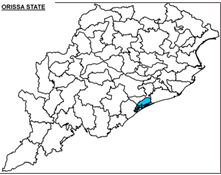 The total number of fish species is reported to be more than 225. Along with a variety of phytoplankton, algae, and aquatic plants, the lagoon region also supports over 350 species of non aquatic plants. A survey carried out by the Zoological Survey of India in 1985-87 recorded over 800 species of fauna. This represents a solid ecological foundation to the lagoon’s small-scale fisheries system.
The total number of fish species is reported to be more than 225. Along with a variety of phytoplankton, algae, and aquatic plants, the lagoon region also supports over 350 species of non aquatic plants. A survey carried out by the Zoological Survey of India in 1985-87 recorded over 800 species of fauna. This represents a solid ecological foundation to the lagoon’s small-scale fisheries system.
The Chilika community
Regional biodiversity is an integral part of sustaining the culture and livelihoods of the roughly 400,000 fishers and their families, who live in more than 150 villages. People in these villages have been engaging in customary fishing occupations for generations. The fishery consists of traditional fisher groups whose vocation is identified by their membership in certain Hindu castes: there are seven different types of fisher castes and five sub-castes in Chilika.
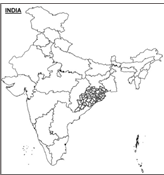
The lagoon ecosystem also indirectly supports 800,000 non- fisher higher caste villagers (e.g. Brahmins, Karans, Khandayat and Khetriyas) in the watershed areas, whose occupants traditionally engage in farming, forestry and other livelihood occupations.
Conservation and livelihood challenges
Due to large-scale forest and land degradation, subsistence based on agriculture and forestry is on the decline. Consequently, a number of non-fisher caste members have now turned to aquaculture, and in some cases regular capture fishing, as a growing source of income.
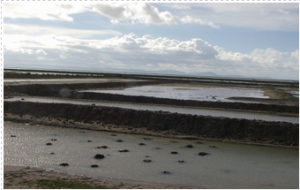
Figure 2: Chilika Aquaculture.
In the 1980s, for example, as shrimp aquaculture grew, questions arose about access, usage rights and changes to the rules of the game in the lagoon fish economy. Several policy changes were implemented in early 1990s to support aquaculture, including provisions to lease out lagoon areas to non-fishers for aquaculture activities. Another detrimental force on the Chilika lagoon was the opening of a new sea mouth to the Bay of Bengal in 2001, which has had a direct impact on biophysical processes and, by extension, associated livelihood systems. Some of the key challenges resulting from the above two scenarios are described below:
Conservation consequences
- Disturbance of the salinity regime and the fresh water/saltwater balance.
- Random changes in water depth.
- Increase in sand deposits, especially in the lagoon’s outer channel areas near the new sea mouth.
- Changes in the nature of the water inflow and outflow during high and low tides.
- Infestation of barnacles affecting both fishers and their equipment.
- Sudden appearance of what local people call sea creatures, such as the stingray, octopus and jelly fish.
Social and livelihood consequences
- Fish production reached an all-time low, and the small-scale fisher economy, efficiently run by caste-based fishers and their organisations for centuries, began to collapse.
- Household incomes dropped as a result of the decline in fish production, contributing to the loss of fishery-based livelihoods.
- Local subsistence and household economies came under stress, severe food insecurity in fisher communities became evident, increasing fishers’ dependence on staggering amounts of cash loans with interest rates of 60-120% per annum.
- More than one-third of adult fishers and their families were occupationally displaced from fishing and either migrated to urban centers as unskilled workers or took up daily wage labor.
- Elite capture of customary fishing areas through encroachment acted as a vehicle for the growth of aquaculture in Chilika. Influential people took control of the lagoon resulting in serious issues around fishers’ access rights and entitlements.
Community Initiatives
Fishers use a well-known metaphor which best explains the level of their response to these challenges and initiatives: “For the poor, when hunger becomes unbearable, movement and protest becomes our last resort.” This suggests that social and political struggles and movements are the ultimate options for the fishers when social, economic, political and environmental problems become rampant. Fishers realise that when everything seems to be going against them and nothing really works in their favour, coming together to protest the acts of the external forces becomes an obligation.
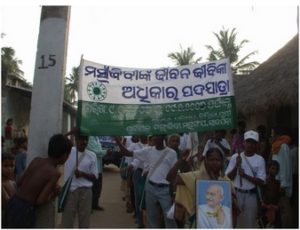
Figure 3: Chilika fisher protest movement.
In the past, such protest movements have been effective. In 1992, for example, the Tata Industrial Group withdrew due to massive protest and lobbying by fishers which resulted in a denial of environmental clearance to the corporation from the central environment ministry. Legal activism gave rise to successful court cases in the State High Court and Federal Supreme Court, leading to a ban on aquaculture in and around the lagoon.
In 1999, an anti-aquaculture protest movement was launched by the Fisher Federation with support from the National Fishworkers Forum (India) and the World Forum of Fish Harvesters and Fish Workers. The Chilika Fisher Federation continues to play a leadership role in fighting for fishers’ rights.
Livelihood reactions from fishers include efforts at diversification of occupation such as seasonal outmigration and non-fishing income activities.
Traditional village institutions have taken initiative to fill the gap created by the gradual dysfunctionality of the primary fishing cooperative societies due to recent policy changes and decrease in fish production. To plan for the future, within the villages, several community meetings and policy workshops have been held.
During 2018, the Chilika Development Authority undertook one of the largest ever removal of illegal aquaculture activities in the lagoon as per the pending court orders. As a result, close to 100% of aquaculture farms closed down in Chilika. The government initiative was viewed in a positive light by the fisher communities and became a landmark event in rebuilding collaboration with the state departments. However, given the involvement of powerful people and social elites in aquaculture, and due to local caste politics, it remains to be seen whether (and how soon) the lagoon might be back under the aquaculture influence again.
Practical Outcomes
A series of specific proposals arose from community meetings, including:
- Fishers expressed their desire for priority to be given to community level institutions, while also recognising that other institutions at multiple levels can work together with local institutions.
- Communities feel that the dominance of higher-level government institutions can be minimised and bottom-level institutions, who often do not get an opportunity to participate in fishery related decision-making, should gain some much-required political space and voice.
- The fishers also noted the need to revise some of the earlier institutions that have been dissolved by the government, such as the Central Fishermen Cooperative Marketing Society, or those that have become dysfunctional such as the Primary Fishermen Cooperative Societies at the village level.
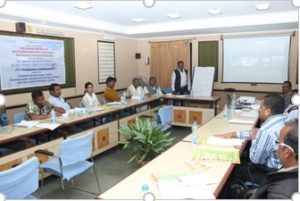
Figure 4: Fisher presentation at a policy workshop.
Along with the above points, the fishers are interested in pursuing a possible solution to the governance issues faced in the Chilika lagoon through the introduction of a polycentric system of governance – one which would involve multiple authorities at differing scales, rather than a monocentric unit, and with each authority having considerable independence to make their own norms and rules. Suggestions for polycentric arrangements came from the fishers, with a key element being that the fishery institutions in the Chilika lagoon would have some authority to create regulations, to tap the community’s local knowledge and learn from others engaged in similar systems.
Although many of the required institutions are already present in the lagoon, a shift to a polycentric arrangement would make the responsibilities and the authorities of each institution clear, and make it easier to hold institutions accountable when they detract from their responsibilities. Fostering communication between governing authorities would, for example, elicit and share information about what has worked well in one setting of the lagoon, ensuring that if one governing authority fails there are others that can be relied upon.
References
- Nayak, P. K. and F. Berkes. 2010. ‘Whose marginalisation? Politics around environmental injustices in India’s Chilika Lagoon’. Local Environment 15(6): 553–567. Available at: https://doi.org/10.1080/13549839.2010.487527
Additional Reading on Chilika Lagoon
Nayak, P.K. (2014). ‘The Chilika Lagoon Social-Ecological System: An Historical Analysis’. Ecology and Society 19(1): 1. Available at: http://dx.doi.org/10.5751/ES-05978-190101
Nayak, P.K. (2015). ‘Institutional Pluralism, Multilevel Arrangements and Polycentricism: The Case of Chilika Lagoon, India’. In: M. Bavinck and A. Jyotishi (eds.), Conflict, Negotiations and Natural Resource Management: A legal pluralism perspective from India, pp. 148–177. London, UK: Routledge.
Nayak, P.K. (2017). ‘Conditions for Governance of Tenure in Lagoon-Based Small-Scale Fisheries, India’. In: S. Jentoft, R. Chuenpagdee, M.J. Barragán-Paladines, N. Franz (eds.), The Small-Scale Fisheries Guidelines: Global Implementation, pp. 165–189. The Netherlands: Springer. Available at: https://doi. org/10.1007/978-3-319-55074-9
Nayak, P.K. (2017). ‘Fisher communities in transition: understanding change from a livelihood perspective in Chilika Lagoon, India’. Maritime Studies 16:13. Available at: https://doi.org/10.1186/ s40152-017-0067-3
Nayak, P.K. and Armitage, D. (2018). ‘Social-ecological regime shifts (SERS) in coastal systems’. Ocean and Coastal Management 161: 84–95. Available at: https://doi. org/10.1016/j.ocecoaman.2018.04.020
Nayak, P.K., Oliveira, L.E. and Berkes, F. (2014). ‘Resource degradation, marginalization, and poverty in small-scale fisheries: threats to social-ecological resilience in India and Brazil’. Ecology and Society 19(2): 73. Available at: http:// dx.doi.org/10.5751/ES-06656-190273
Acknowledgements
I would like to thank the fishers of Chilika Lagoon for their unconditional friendship, support and collaboration. My work in Chilika has been funded by the Social Sciences and Humanities Research Council (SSHRC) of Canada.
See below for the Odia language abstract for this community story.
